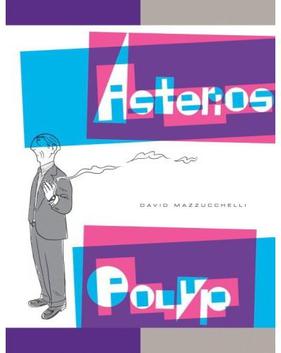So my parents just got me an absolutely dynamite piece of work.
In 2009 David Mazzucchelli published his latest graphic novel Asterios Polyp. I have never heard of Mazzucchelli before (apparently he has been involved in the graphic novel industry since the early 80's and has built quite an esteem around his name) The book got a ton of hype since it was released and my sequential art (comic books) teacher talked it up in class so I was glad to get the opportunity to read it.
I am about half way through right now and I will just say it straight up: this graphic novel is utterly delightful. The book deals primarily with personal perceptions (how we view the world, how others view it, how others view us and how we view others) This thing is nothing if not deep. Early on the dominant themes of the book are established and from there almost every panel is laden with visual (and written) representations of these themes. Its the kind of visual play that some of my favorite graphic novelists (Charles Burns, for one) try so hard to bring across. As you read the book the motifs become clear and when you look back at previous images you realize there were visual interpretations of these motifs running through the whole thing the entire time. The main critique I could see this book getting is that it is a little "smarmy" Mazzucchelli goes heavy with the references in this one (I find myself constantly on the internet as I read this thing wikipedia-ing philosophers and historical figures that keep getting alluded to) but while the characters in the book that make these references often come off as pretentious (as they were intended to) personally I never feel that the book becomes too full of itself.
The reason being is that Mazzucchelli comes at the whole thing with a beautiful art style. There is a delightful simplicity in every panel he designs that never feels limited by Mazzucchelli's artistic restraints. Nothing is heavily rendered, backgrounds pop in and out and even perspective sometimes comes and goes as it pleases but none of this should bother the average reader even for a second because Mazzucchelli is thorough with establishing this style. Every panel, no matter how simple, plays along with certain "rules" set up by the artist and no two panels really contradict themselves so you never end up questioning the art style as a whole. There is a playfulness to everything that truly helps to limit the noise in the air writing style that comes with some of the characters. Characterization too, is something Mazzuchelli does quite well. Each character is believably written within themselves and they never seem to contradict their character at any one time. Also, each character is sculpted with specific, repeated design elements (line weight used in drawing them, typeface used for their speech bubbles and the speech bubbles themselves) that only go to reinforce their presence as a fully functioning character in your mind. From speech bubble one for each character I immediately hear a distinct voice in my head geared around how Mazzuccchelli designed them and it isn't hard for me to imagine the characters existing outside of the panels they are drawn in.
If it isn't clear I highly recommend seeking this book out. I realize though that your library probably does not have a bountiful resource of graphic novels so take this post as more of a suggestion. Be on the lookout for this book and if you have an opportunity, at least give it a glimpse. As with most graphic novels the whole thing shouldn't take more than a day or two to complete.

I can't analyze the work too deeply, but I will say that I enjoyed it, even with the ending. There is something about architects that's so appealing to storytellers. I think its the fact that their artists, but they produce such a functional product. With the ending I felt like perhaps it brings back the question of duality, which surfaces a couple times. Is it a happy ending? A sad ending? It doesn't really fit either of those labels. What I don't like about the ending is that it truncates what was a realistic and sad story. What if they hadn't gotten back together, and he'd lived out his life fixing cars or working odd jobs. How would the reader feel with that story?
ReplyDelete